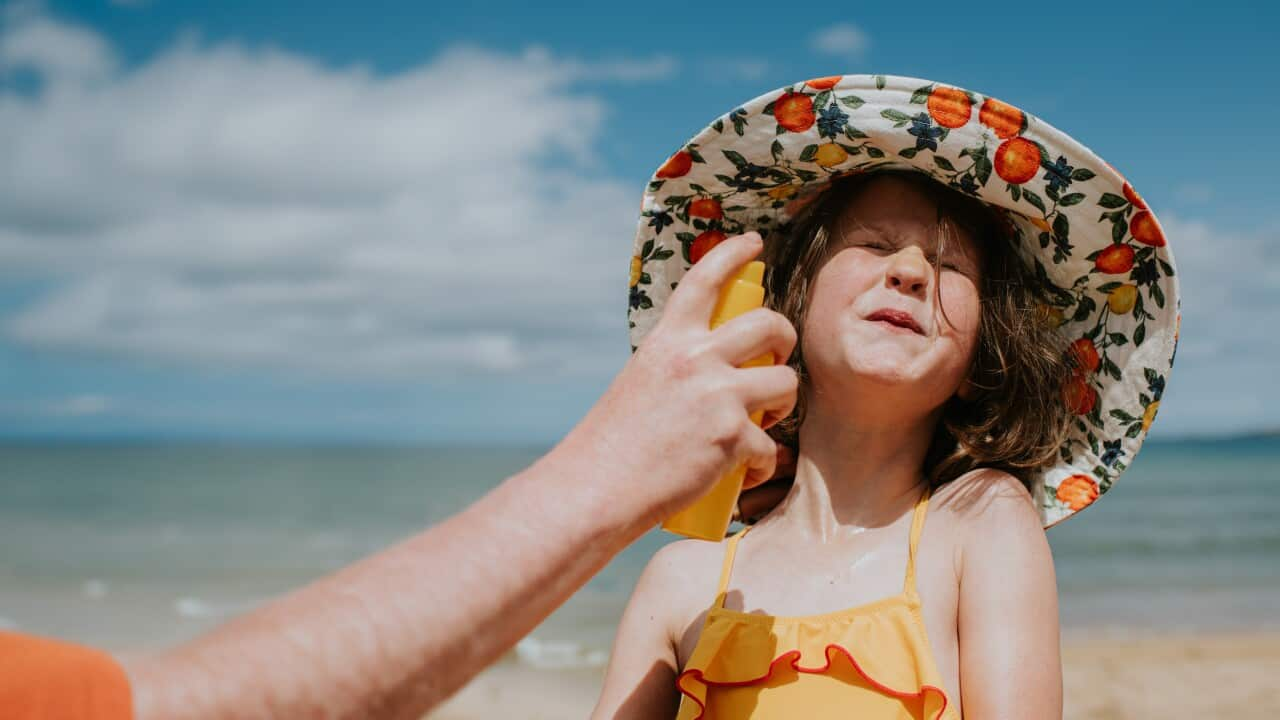Key Points
- According to the ABS and Cancer Council, only 53.9 per cent of Australians use adequate sun protection.
- Australia has one of the highest skin cancer rates in the world.
- Internationally and in Australia, scientists are concerned about the spread of myths about sunscreen products by social media influencers.
"Nothing makes me feel more like I’m pushing a rock repeatedly up a mountain than sunscreen season," says Dr Michelle Wong, Sydney-based chemist and science educator.
In one of her videos she is going through several sunscreen myths spreading on TikTok — from recipes of DIY-sunscreen to links between chemicals used in sunscreens and cancer. And she debunks them one by one.
"Every year all the same myths about sunscreen go viral again. Sometimes someone invent some brand new ones too."
Earlier this year, an article published in the Clinics in Dermatology medical journal highlighted the role social media influencers play in spreading misinformation about sunscreen.
With younger people predominantly using these platforms, the impact of misinformation on public health might last well into the future, scientists say.
Recent data from the Australian Bureau of Statistics showed that young Australians aged 15-24 years are less likely to protect themselves from sun exposure during peak UV times. While almost half of Australians in general do not use adequate sun protection.
With Australia sitting almost at the top of world’s skin cancer rates, scientist are urging people to be cautious on social media platforms, and continue to use sunscreen and other forms of sun protection.
But what are the myths to watch out for and what do the scientists say about them?
READ MORE

Tasmania has a sunburn problem
Does sunscreen cause cancer?
Professor Rachel Neale, senior group leader at the QIMR Berghofer Medical Research Institute in Queensland, says there is definitive proof that sunscreen reduces the risk of skin cancer.
Speaking to SBS News, she referred to a randomised study involving 1600 people.
"We asked half of them to use sunscreen every single day as part of their normal daily routine for four-and-a-half years," she said.
"And then we asked the other half to just do whatever they would normally do, which was not very much sunscreen use."
Neale said the group that used sunscreen had a reduced risk of skin cancer, reduced risk of premalignant lesions, and reduced risk of ageing of the skin.
"So we've got some really definitive evidence that sunscreen actually works [to reduce the risk of cancer]."
But what about the chemicals in sunscreen?
In 2020, the US Food and Drug Administration (FDA) published a report — Shedding More Light on Sunscreen Absorption — that said absorption of chemicals from sunscreen does happen.
Neale said that doesn’t mean the chemicals are doing any harm.
"At the moment we've got definitive evidence of benefit, but we don't have any evidence of harm," she said.
"In fact, a lot of the chemicals that people are concerned about, we actually get [them] from other products as well."
Neale added that during its study, the FDA put sunscreen on people’s entire bodies multiple times.
She also said there is too much emphasis on sunscreen as the only way of protection.
"We actually don't recommend that sunscreen is used like that anyway. We recommend that clothing is the first line of defence," she said.
"One thing I would say though, is that I personally use a chemical sunscreen every day, because I am acutely aware of my risk of skin cancer.
"I'm covering as much of me with clothing as I can and only putting sunscreen on the bits of me that can't be covered by clothing."
Is the most expensive sunscreen the best one?
No. As Neale explained, the more expensive products have often put a bit more time and investment into how the sunscreen feels on the skin.
"So that's where it is, it's about the feel rather than the actual effectiveness of the sunscreen.
"So long as it's a labelled SPF (Sun Protection Factor), it's approved by the TGA (Therapeutic Goods Administration), it's a perfectly good sunscreen."
What about DIY-sunscreens?
Neale said she wouldn't recommend anyone use a DIY-sunscreen, as there are risks they don't provide adequate sun protection.
What are Australia’s cancer stats this year?
Being mostly a sunny continent, some parts of Australia receive between seven to 11 hours of daily sunshine on average throughout the year.
However, according to the Cancer Council, it’s not only about the sun. Sun damage is caused by ultraviolet (UV) radiation, meaning you can still damage your skin when the sun isn’t out.
Australia has some of the highest levels of UV radiation in the world, and UV radiation is strong enough to cause sunburn in as little as 11 minutes on a fine summer day.
According to the Cancer Council, in Australia, up to 95 per cent of melanomas can be attributed to overexposure to UV radiation.
Melanoma is the third most commonly diagnosed type of cancer in Australia and the 11th leading cause of death.

According to Cancer Council, in Australia, up to 95 per cent of melanomas are attributable to overexposure to UV radiation. Skin cancer risk is not just related to the amount of sun exposure, but also to the pattern, for example low sun exposure in daily life combined with high sun exposure during the hollidays.

According to the recent joint study by Cancer Council and the Australian Bureau of Statistics, Australians are not using adequate sun protection to reduce their risk of skin cancer, with new data revealing that only half (53.9 per cent) of Australians are using three or more forms of sun protection when exposed to the sun during peak UV times.
Does sunscreen 'block' vitamin D?
Neale explained there is some foundation in that, as the wavelengths in sunshine that produce vitamin D overlap with the wavelengths that cause sunburn.
"In studies that have been done in experimental settings, there's no doubt that when you put sunscreen on before you expose someone to artificially generated UV radiation, that the increase in vitamin D is lower than when you expose skin that hasn't had sunscreen applied," she said.
"But the trials that have been published so far, did not show that people randomised to daily sunscreen application had lower vitamin D than the people not randomised to daily sunscreen application."
What about people with vitamin D deficiency?
Neale said people who are already vitamin D deficient shouldn't rely on sun exposure to treat the deficiency.
"Supplements work effectively and they're cheap and safe. So vitamin D deficiency should be treated with a vitamin D supplement."
Sunscreen as the baseline only
Neale said people too often tend to conflate sun protection with sunscreen.
"Most of us should be putting it on every day as part of our normal daily routine, but that's just to protect us if we happen to pop outside when we're not planning to," she said.
"You suddenly find yourself walking to the cafe to buy your lunch because you forgot it that day. That was to protect you during those sorts of activities.
"But during planned outdoors activities, it should be the last line of defence. We should be staying in the shade, covering up with clothing, wearing hats, avoiding really high UV-times.
"There are many other ways of protecting ourselves, yet we tend to assume that sun protection means sunscreen."











